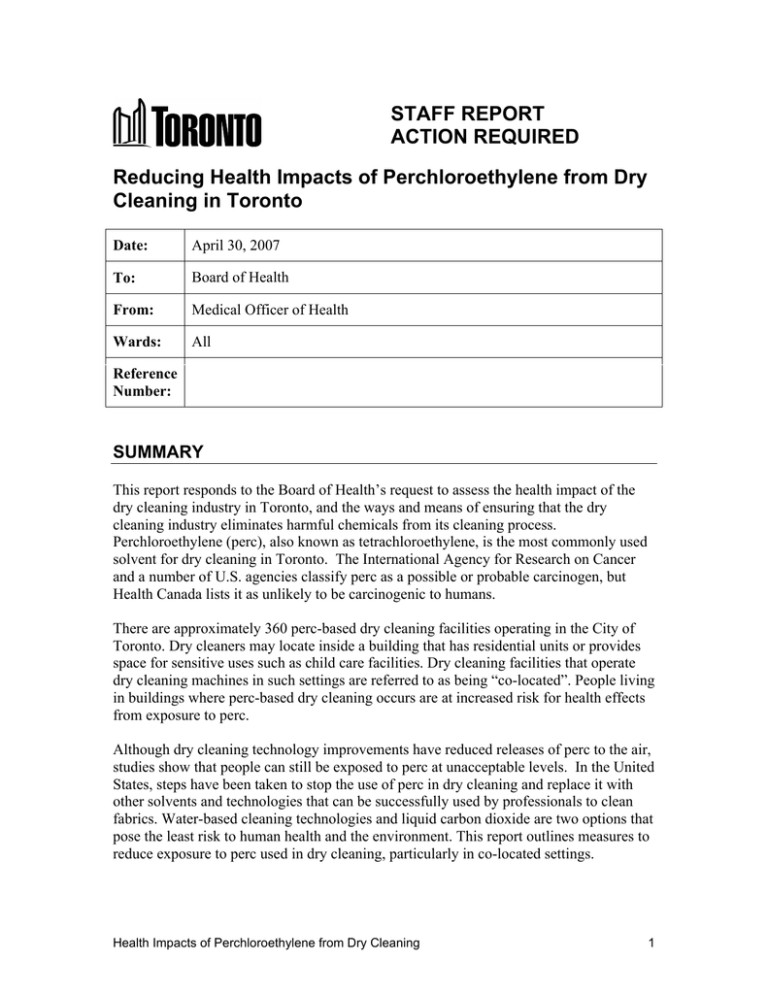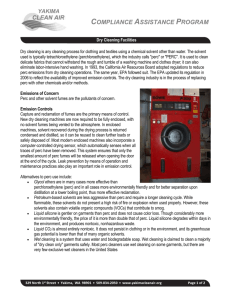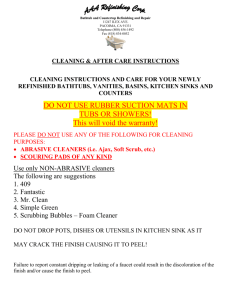STAFF REPORT ACTION REQUIRED Reducing Health Impacts of Perchloroethylene from Dry
advertisement

STAFF REPORT ACTION REQUIRED Reducing Health Impacts of Perchloroethylene from Dry Cleaning in Toronto Date: April 30, 2007 To: Board of Health From: Medical Officer of Health Wards: All Reference Number: SUMMARY This report responds to the Board of Health’s request to assess the health impact of the dry cleaning industry in Toronto, and the ways and means of ensuring that the dry cleaning industry eliminates harmful chemicals from its cleaning process. Perchloroethylene (perc), also known as tetrachloroethylene, is the most commonly used solvent for dry cleaning in Toronto. The International Agency for Research on Cancer and a number of U.S. agencies classify perc as a possible or probable carcinogen, but Health Canada lists it as unlikely to be carcinogenic to humans. There are approximately 360 perc-based dry cleaning facilities operating in the City of Toronto. Dry cleaners may locate inside a building that has residential units or provides space for sensitive uses such as child care facilities. Dry cleaning facilities that operate dry cleaning machines in such settings are referred to as being “co-located”. People living in buildings where perc-based dry cleaning occurs are at increased risk for health effects from exposure to perc. Although dry cleaning technology improvements have reduced releases of perc to the air, studies show that people can still be exposed to perc at unacceptable levels. In the United States, steps have been taken to stop the use of perc in dry cleaning and replace it with other solvents and technologies that can be successfully used by professionals to clean fabrics. Water-based cleaning technologies and liquid carbon dioxide are two options that pose the least risk to human health and the environment. This report outlines measures to reduce exposure to perc used in dry cleaning, particularly in co-located settings. Health Impacts of Perchloroethylene from Dry Cleaning 1 RECOMMENDATIONS The Medical Officer of Health recommends that: 1. the Board of Health request the federal Minister of Health to recognize perchloroethylene as a probable carcinogen consistent with leading agencies such as the International Agency for Research on Cancer; 2. the Board of Health request the federal Minister of Environment to eliminate the use of perc in dry cleaning in Canada by the earliest date possible and to encourage professional fabric cleaners to replace it with water-based cleaning and other inorganic solvent-based technologies; 3. the Medical Officer of Health, in collaboration with other City divisions, consult with the dry cleaning industry and other community stakeholders to explore possible options to reduce the use of perc in the short term; and 4. the Medical Officer of Health report to the Board of Health in February 2008 on the feasibility of municipal regulation to phase out the use of perchloroethylene in dry cleaning facilities which are co-located with residential or other sensitive uses. Financial Impact There are no financial impacts resulting from this report. DECISION HISTORY At its November 28, 2005 meeting, the Toronto Board of Health, requested the Medical Officer of Health to report on the public health impact of the dry cleaning industry in Toronto, and the ways and means of ensuring the dry cleaning industry eliminate harmful chemicals from its cleaning process. ISSUE BACKGROUND Tetrachloroethylene, also known as perchloroethylene or perc, is the most common solvent used for dry cleaning in Toronto. Perc is classified as a probable carcinogen by the International Agency for Research on Cancer (IARC). It is identified as one of the ten key carcinogens in Toronto workplaces and environment by Toronto Public Health in a 2002 report < http://www.toronto.ca/health/pdf/cr_summaryreport.pdf> . With the support of the Toronto Cancer Prevention Coalition, the issue of perc use at dry cleaning facilities was brought to the Board of Health by the residents of a condominium building. The residents were concerned about the proposed use of perc at a new dry cleaning and laundry facility scheduled to open in their building. Health Impacts of Perchloroethylene from Dry Cleaning 2 COMMENTS The dry cleaning industry in Toronto consists of institutional, retail, and industrial operations. Most dry cleaners are small family-owned operations employing four to six people. There are about 360 perc-based dry cleaning facilities in Toronto. Toronto also has professional fabric cleaning operations that do not use perc. Some of these operate wet cleaning machines where water is the solvent. Wet cleaning is also known as “green cleaning”. Toronto dry cleaners also use hydrocarbon solvents and to a lesser extent, volatile methyl siloxane based solvents for cleaning fabric. Toronto Public Health undertook a review of the human health risks resulting from the use of perc in dry cleaning, along with an assessment of alternative fabric cleaning technologies, and the health protective measures taken by other U.S. agencies. In addition, preliminary discussions were held with some representatives of Toronto’s dry cleaning industry to identify issues relevant to Toronto. A technical report <http://www.toronto.ca/health/hphe/toxic_chemicals/toxicchemicals.htm> was prepared to inform an effective course of action that the City of Toronto can take to protect those most at risk from exposure to perc from dry cleaning. Exposure to Perchloroethylene Perc does not occur naturally in the environment. It is a manufactured chlorinated solvent used mainly by the dry cleaning and metal cleaning industry. It is also found in some consumer products such as water repellents and wood cleaners. The dry cleaning industry uses 75% of the total perc consumed in Canada. An Environment Canada estimate shows that in 2005 about 205 tonnes (205,000 kg) of perc was purchased for use in dry cleaning in Toronto, which accounts for around 40% of the total perc purchased in Ontario for dry cleaning. Information on actual emissions of perc in Toronto by each dry cleaning site, as well as, information on perc use provided by dry cleaners to Environment Canada as required by the Tetrachloroethylene (Use in Dry Cleaning and Reporting Requirements) Regulations, under the Canadian Environmental Protection Act (CEPA) is not readily accessible to the public. Perc is listed as a reportable substance under Environment Canada’s publiclyaccessible database, the National Pollutant Release Inventory (NPRI) which is legislated under the authority of the Canadian Environmental Protection Act (CEPA). However, dry cleaning facilities in Toronto rarely need to report perc use because most facilities are small-scale operations that are exempt from the reporting requirements of the NPRI. Perc easily evaporates and is released into the air during certain steps in the dry cleaning process. Data collected in the U.S. reveal that despite improved emission control technology in the newer dry cleaning machines, the dry cleaning process is still likely to release some perc into the air. Breathing in perc is the most common way in which the public comes in contact with this solvent. Health Impacts of Perchloroethylene from Dry Cleaning 3 Health Effects of Perchloroethylene The main health effects that have been associated with long-term contact through breathing in perc are carcinogenicity and harmful effects on the central nervous system, kidney, liver, and on reproduction and development. Breathing in high levels of perc for short periods of time is associated with irritation of the nose and throat, and with effects on the central nervous system including symptoms such as drowsiness, dizziness, giddiness, headache, nausea, loss of coordination, confusion, unconsciousness, and even death at very high levels. The International Agency for Research on Cancer (IARC) has classified perc as a probable human carcinogen (Group 2A). The United States Environmental Protection Agency (USEPA) considers perc to be intermediate between a probable and possible human carcinogen, and the U.S. Department of Health & Human Services classifies perc as “reasonably anticipated to be a human carcinogen”. Health Canada, however, has categorized perc as “unlikely to be carcinogenic to humans” (Group IV). These differences in how perc is classified relate to how the science from human and animal studies has been assessed. Toronto Public Health considers perc a probable human carcinogen consistent with the International Agency for Research on Cancer. Perchloroethylene Exposure In Co-located Buildings In Toronto, dry cleaners may locate inside a building that also has residential units or provides space for sensitive uses such as child care facilities. In this report, dry cleaning facilities that operate dry cleaning machines in such settings are referred to as being “colocated”. Perc vaporises easily and can pass through ceilings, walls and vents throughout a building. It can enter adjacent buildings, and may even remain in building materials. Indoor air is the largest exposure pathway for people. Studies done in New York City show that apartments located in buildings where percbased dry cleaning also occurs had higher than average levels of perc in indoor air. In 1998, New York State passed legislation requiring co-located dry cleaners to install extra protective measures, such as vapour barriers to prevent exposure to residents and workers. However, studies conducted from 2001 to 2003, after that law came into effect, continued to show that perc levels were higher than normal background levels in residential units located above a dry cleaning facility. The average levels of perc found in these apartments are 20 –fold above the 1 in 1 million lifetime cancer risk value estimated by the USEPA and 200-fold higher than CalEPA’s health benchmark for lifetime cancer risk. In other words, long-term exposure at levels described above are expected to increase cancer risk. These studies also found that residents and child care workers in the building experienced neurotoxic effects such as disrupted visual function and altered cognitive processing of visual information from exposure to perc. People living in buildings where the structure allows perc vapours to travel throughout the building are especially at an increased risk of breathing in perc from dry cleaning operations in the building. Health Impacts of Perchloroethylene from Dry Cleaning 4 Legislation Regarding the Use of Perc Perc use in dry cleaning in Toronto is subject to the Tetrachloroethylene (Use in Dry Cleaning and Reporting Requirements) Regulations, under the CEPA. These regulations require dry cleaners to reduce perc emissions by minimizing spills, controlling fugitive emissions from the machines, managing disposal of waste water and using machines with a specified efficiency rating. Despite these requirements the public may still be at risk of being exposed to perc vapours from dry cleaning. Perc’s ability to easily evaporate means that the public is exposed to perc that is released into the air during the dry cleaning process, and also from the small amounts of perc that are released or ‘off-gassed’ from dry cleaned clothes that are held in depots and brought home. Ontario Regulation 323/94 made under the Environmental Protection Act, requires that facilities using certain solvents, including perc or hydrocarbon solvents, have a full-time person trained in the management of waste and contaminants resulting from the operations. Dry cleaning operations must also comply with City of Toronto by-laws that apply to the operation of a business or commercial operation in the city. Those wishing to open a business involving washing/ironing and the use of washing machines or dryers, are required to apply for a business license from the Municipal Licensing and Standards (MLS) division of the City of Toronto. The use of solvents for dry cleaning, however, is currently not in the scope of the Licensing by-law. The Toronto Sewer Use by-law applies to dry cleaning facilities since it limits discharges of perc into sanitary sewers and storm sewers. Dry cleaners are also required to submit a pollution prevention plan to Toronto Water as part of Toronto Water’s strategy to control the release of perc into the sewer system. Approaches to Reducing or Eliminating the Use of Perc-based Dry Cleaning 1. Reduce Emissions Perc releases from dry cleaning operations have been reduced significantly by the introduction of emission control mechanisms built into the machines. The newer machines have improved features such as drying sensors, carbon adsorption, cycle lockout, refrigerated condensers and closed-loop systems. These features have led to lower fugitive emissions of perc. Perc demand in Canada declined between 1994 and 2000, driven by a 56% reduction in its use by the dry cleaning industry. As well, the overall reduction in public demand for dry cleaning attributed to relaxed workplace dress codes explains some of the decrease in perc use. Although technological advances may help limit fugitive emissions from dry cleaning machines, it does not eliminate perc emissions during the cleaning process. In addition, perc may be released into the air from accidental spills of perc in the workplace and from the small amounts of perc that are off-gassed from dry cleaned clothes. Health Impacts of Perchloroethylene from Dry Cleaning 5 2. Use Safer Alternatives Professional fabric cleaners have the option of using several other technologies instead of those requiring perc. The common alternatives are: water-based (wet cleaning), hydrocarbon solvent cleaning, carbon dioxide cleaning, and silicone-based solvent cleaning. Among Toronto dry cleaners, hydrocarbon solvents are the preferred alternative to perc. Toronto Public Health’s review of the known health impacts from using other chemicals or alternative cleaning technologies shows that water-based cleaning and liquid carbon dioxide cleaning will have the lowest impact on human health and the environment. According to the California Environmental Protection Agency, this technology does not contribute to global warming since the CO2 used in the process is the by-product of other industrial processes and therefore, there is no net increase in CO2. There are no known carbon dioxide-based professional fabric cleaners in Toronto. This is likely due to the high cost of the machinery, which is estimated to be US $140,000. Water-based cleaning is being used in Toronto, either in combination with perc-based cleaning or as the only cleaning technology used at the facility. Some members of the dry cleaning industry have expressed concern that water-based cleaning is not suitable for cleaning certain fabrics or types of garments. Those who use only water-based cleaning, however, say that this technology works well for cleaning all fabrics that can be cleaned by perc-based technology, as long as the operator is properly trained in the wet cleaning process. Other factors important for successfully applying wet cleaning are that wet cleaning equipment is installed properly and that operators have the opportunity to observe the wet cleaning process. Hydrocarbon-based solvents are not recommended as alternatives to perc. Hydrocarbon solvent is a volatile organic compound (VOC) and as such, emissions to the atmosphere contribute to the formation of ground level ozone. Ozone is a pollutant that is associated with respiratory and cardiovascular health effects. Affected people also have a greater chance of being hospitalized or of dying. Similarly, silicone-based solvents may be a human health concern since animal studies have found uterine tumours in female rodents exposed to this solvent. 3. Phase Out the Use of Perc through Legislation The requirements under the dry cleaning regulations introduced by Environment Canada in 2003 are not based on the most stringent measures that can be taken to protect the public from exposure to perc from dry cleaning. Other jurisdictions in the United States have taken a more proactive approach. In the United States, where most agencies consider perc a probable or possible human carcinogen, measures have been taken to eliminate the use of perc in dry cleaning. The USEPA recently passed legislation that will gradually eliminate perc use in dry cleaning facilities that are located in residential buildings. Health Impacts of Perchloroethylene from Dry Cleaning 6 The California Environmental Protection Agency passed a rule to eliminate perc-based cleaning at all dry cleaning facilities in the state of California by 2023. This rule requires co-located dry cleaners to phase out perc machines by 2010 and prohibits new installation of perc machines as of January 1, 2008. New York State requires perc-based dry cleaning facilities located in mixed-usecommercial or mixed-use-residential buildings to install vapour barriers around equipment. The Recommended Approach An assessment of exposure risks shows that, among the general population, those living in buildings that also have dry cleaning facilities where perc is being used are more likely to be exposed to higher than average levels of perc. We can also expect that sensitive uses, such as child care centres, that are in the same building where perc-based dry cleaning occurs would also be exposed to higher than average levels of perc. Eliminating the use of perc at all dry cleaning facilities is the most health protective measure. However, perc-based dry cleaning is well established in Toronto and it is unlikely that it can be phased out immediately either voluntarily or through regulation. Toronto Public Health recommends that the Board of Health encourage the federal government to recognize the probable carcinogenicity of perchloroethylene consistent with the International Agency for Research on Cancer and to set a date through regulation as early as possible to phase out the use of perc at all dry cleaning facilities. In addition, Toronto Public Health recommends that municipal regulatory strategies be explored to phase out perc use in dry cleaning facilities located in residential buildings and sensitive areas in the City of Toronto. Further community and industry consultation and a review of the City’s municipal authority in this area is necessary to determine the most appropriate regulatory approach. CONTACT Loren Vanderlinden Supervisor, Environmental Protection Office Toronto Public Health Phone: 416-338-8094 Fax: 416-392-7418 Email: lvander@toronto.ca Health Impacts of Perchloroethylene from Dry Cleaning 7 Sudha Sabanadesan Research Consultant Environmental Protection Office Toronto Public Health Phone: 416-338-8143 Fax: 416-392-7418 Email: ssabana@toronto.ca SIGNATURE _______________________________ Dr. David McKeown Medical Officer of Health Health Impacts of Perchloroethylene from Dry Cleaning 8







